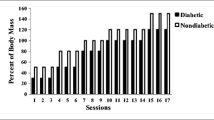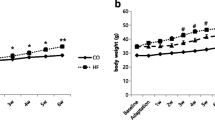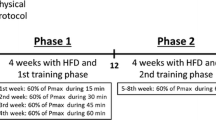Abstract
Heat shock proteins (HSPs) play an important role in insulin resistance and improve the cellular stress response via HSP induction by exercise to treat type 2 diabetes. In this study, the effects of exercise-induced HSP72 expression levels on whole-body insulin resistance in type 2 diabetic rats were investigated. Male 25-week-old Otsuka Long-Evans Tokushima Fatty rats were divided into three groups: sedentary (Sed), trained in a thermal-neutral environment (NTr: 25 °C), and trained in a cold environment (CTr: 4 °C). Exercise training was conducted 5 days/week for 10 weeks. Rectal temperature was measured following each bout of exercise. An intraperitoneal glucose tolerance test (IPGTT) was performed after the training sessions. The serum, gastrocnemius muscle, and liver were sampled 48 h after the final exercise session. HSP72 and heat shock cognate protein 73 expression levels were analyzed by Western blot, and serum total cholesterol, triglyceride (TG), and free fatty acid (FFA) levels were measured. NTr animals exhibited significantly higher body temperatures following exercise, whereas, CTr animals did not. Exercise training increased HSP72 levels in the gastrocnemius muscle and liver, whereas, HSP72 expression was significantly lower in the CTr group than that in the NTr group (p < 0.05). Glucose tolerance improved equally in both trained animals; however, insulin levels during the IPGTT were higher in CTr animals than those in NTr animals (p < 0.05). In addition, the TG and FFA levels decreased significantly only in NTr animals compared with those in Sed animals. These results suggest that attenuation of exercise-induced HSP72 expression partially blunts improvement in whole-body insulin resistance and lipid metabolism in type 2 diabetic rats.





Similar content being viewed by others
References
Adachi H et al (2010) An acylic polyisoprenoid derivative, geranylgeranylacetone protects against visceral adiposity and insulin resistance in high-fat-fed mice. Am J Phys Endocrinol Metab 299:E764–E771. doi:10.1152/ajpendo.00075.2010
Atalay M et al (2004) Exercise training modulates heat shock protein response in diabetic rats. J Appl Physiol 97:605–611. doi:10.1152/japplphysiol.01183.2003
Boden G (1997) Role of fatty acids in the pathogenesis of insulin resistance and NIDDM. Diabetes 46:3–10
Bonen A, Parolin ML, Steinberg GR, Calles-Escandon J, Tandon NN, Glatz JF, Luiken JJ, Heigenhauser GJ, Dyck DJ (2004) Triacylglycerol accumulation in human obesity and type 2 diabetes is associated with increased rates of skeletal muscle fatty acid transport and increased sarcolemmal FAT/CD36. FASEB J 18(10):1144–1146. doi:10.1096/fj.03-1065fje
Chung J et al. (2008) HSP72 protects against obesity-induced insulin resistance Proceedings of the National Academy of Sciences of the United States of America 105:1739–1744 doi:10.1073/pnas.0705799105
Drew BG et al (2014) HSP72 is a mitochondrial stress sensor critical for Parkin action, oxidative metabolism, and insulin sensitivity in skeletal muscle. Diabetes 63:1488–1505. doi:10.2337/db13-0665
Geiger PC, Gupte AA (2011) Heat shock proteins are important mediators of skeletal muscle insulin sensitivity. Exerc Sport Sci Rev 39:34–42. doi:10.1097/JES.0b013e318201f236
Gupte AA, Bomhoff GL, Swerdlow RH, Geiger PC (2009) Heat treatment improves glucose tolerance and prevents skeletal muscle insulin resistance in rats fed a high-fat diet. Diabetes 58:567–578. doi:10.2337/db08-1070
Hamilton KL, Powers SK, Sugiura T, Kim S, Lennon S, Tumer N, Mehta JL (2001) Short-term exercise training can improve myocardial tolerance to I/R without elevation in heat shock proteins. Am J Physiol Heart Circ Physiol 281:H1346–H1352
Henstridge DC et al (2014) Activating HSP72 in rodent skeletal muscle increases mitochondrial number and oxidative capacity and decreases insulin resistance. Diabetes 63:1881–1894. doi:10.2337/db13-0967
Hooper PL, Balogh G, Rivas E (2014) The importance of the cellular stress response in the pathogenesis and treatment of type 2 diabetes. Cell Stress Chaperones 19(4):447–464. doi:10.1007/s12192-014-0493-8
Hooper PL, Hooper PL (2009) Inflammation, heat shock proteins, and type 2 diabetes. Cell Stress Chaperones 14:113–115. doi:10.1007/s12192-008-0073-x
Kawano K, Hirashima T, Mori S, Saitoh Y, Kurosumi M, Natori T (1992) Spontaneous long-term hyperglycemic rat with diabetic complications: Otsuka Long-Evans Tokushima Fatty (OLETF) strain. Diabetes 41:1422–1428
King H, Aubert RE, Herman WH (1998) Global burden of diabetes, 1995-2025: prevalence, numerical estimates, and projections. Diabetes Care 21:1414–1431
Kurucz I, Morva A, Vaag A, Eriksson KF, Huang X, Groop L, Koranyi L (2002) Decreased expression of heat shock protein 72 in skeletal muscle of patients with type 2 diabetes correlates with insulin resistance. Diabetes 51:1102–1109
Liu CT, Brooks GA (2011) Mild heat stress induces mitochondrial biogenesis in C2C12 myotubes. J Appl Physiol. doi:10.1152/japplphysiol.00989.2011
Locke M (1997) The cellular stress response to exercise: role of stress proteins. Exerc Sport Sci Rev 25:105–136
Locke M, Noble EG, Tanguay RM, Feild MR, Ianuzzo SE, Ianuzzo CD (1995) Activation of heat-shock transcription factor in rat heart after heat shock and exercise. Am J Phys 268:C1387–C1394
Naito H, Powers SK, Demirel HA, Aoki J (2001) Exercise training increases heat shock protein in skeletal muscles of old rats. Med Sci Sports Exerc 33:729–734
Ogura Y et al (2008) Elevation of body temperature is an essential factor for exercise-increased extracellular heat shock protein 72 level in rat plasma. American journal of physiology Regulatory, integrative and comparative physiology 294:R1600–R1607. doi:10.1152/ajpregu.00581.2007
Skidmore R, Guitierrez JA, Guerriero V, Kregel KC (1995) HSP70 induction during exercise and heat stress in rats: role of internal temperature. Am J Phys 268:R92–R97
Soti C, Nagy E, Giricz Z, Vigh L, Csermely P, Ferdinandy P (2005) Heat shock proteins as emerging therapeutic targets. Br J Pharmacol 146:769–780. doi:10.1038/sj.bjp.0706396
Zeng XY et al (2015) Identification of matrine as a promising novel drug for hepatic steatosis and glucose intolerance with HSP72 as an upstream target. Br J Pharmacol 172:4303–4318. doi:10.1111/bph.13209
Acknowledgements
This study was supported in part by the MEXT-supported program for Juntendo University and a grant-in-aid for JSPS fellows (13J10819, to T.T.). The Juntendo University Institute of Health and Sports Science & Medicine also supported this research.
Author information
Authors and Affiliations
Corresponding author
Ethics declarations
Conflict of Interest
The authors declare that they have no conflict of interest.
Ethical Statement
All procedures were approved by the Juntendo University Animal Care and Use Committee (H24-01).
Rights and permissions
About this article
Cite this article
Tsuzuki, T., Kobayashi, H., Yoshihara, T. et al. Attenuation of exercise-induced heat shock protein 72 expression blunts improvements in whole-body insulin resistance in rats with type 2 diabetes. Cell Stress and Chaperones 22, 263–269 (2017). https://doi.org/10.1007/s12192-017-0767-z
Received:
Revised:
Accepted:
Published:
Issue Date:
DOI: https://doi.org/10.1007/s12192-017-0767-z




